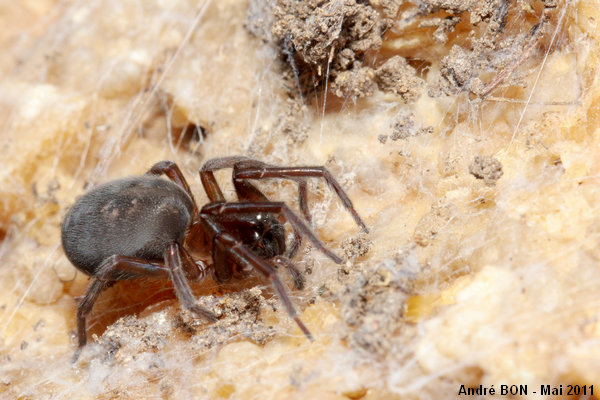



| Black Lace-weaver (Amaurobius ferox (Walckenaer, 1820)) |




|
|
Scientific name: Amaurobius ferox (Walckenaer, 1820) Common name: Black Lace-weaver French name: Amaurobe féroce Order: Araneae Family: Amaurobiidae Size: Body size: 8 to 10 mm for males, 11 to 16 mm for females. Biotope: Cellars, basements and sometimes parks and gardens, under loose barks, under stones, under tree stumps or under wood logs. Web: Irregular, lace-like web made up with cotton-like thread and leading to a rudimentary funnel. This web has a typical bluish sheen. Observation period: You can see females all year long, males in spring or in autumn. Geographic area: Europe, North America. Introduced to New Zeeland. |
The Black Lace-weaver has a dark reddish brown cephalothorax becoming almost black near the eyes. The front is wide and rounded. The anterior median eyes are black, the other eyes are rather greyish. The posterior median eyes are located further at the back than the other eyes. The dark reddish brown, almost black, chelicera are very large. The legs are brown reddish and very slightly ringed. The three first pairs of legs are generally oriented forward. The tarsi of the spiders belonging to the Amaurobius genus show trichobothria (long and mobile setae which are sensitive to vibrations) which are longer than the general pubescence. The abdomen is greyish black with irregular yellowish marks. You can find a general pale form where these marks draw a cardiac mark surrounded by a pale stripe. There are also darker forms. The mother dies shorter after the spiderling hatching and they will feed on its body. There is a possible confusion with the spiders of the Coleotes genus (Agelenidae family). These last one do not spin webs with cribellate silk showing a cotton-like look and a bluish sheen. |
| [To know more about the Black Lace-weaver] [Next picture] [Top] |

|
I have found this Black Lace-weaver under one stone in the garden. You can see the bluish cotton-like web, a few marks on the abdomen. This spider is a rather large size. |
| [To know more about the Black Lace-weaver] [Next picture] [Previous picture] [Top] |

|
Side view. If you look well you can guess some dark rings on the legs. |
| [To know more about the Black Lace-weaver] [Next picture] [Previous picture] [Top] |

|
Front view with the large chelicera, the eye arrangement, the pubescence on the tarsi (I am not skilled enough to say if we can see the trichobothria), and the typical marks on the abdomen (rather dark form). |
| [To know more about the Black Lace-weaver] [Previous picture] [Top] |

|
I think there's Dust Spider Eratigena atrica on the menu for the Black Lace-weaver today. |